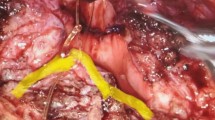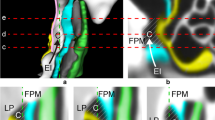Abstract
Background
The object of this study was to assess whether increasing operative experience results in greater endoscopic trans-sphenoidal resection of pituitary macroadenomas and lower complications.
Methods
A retrospective single institution cohort study was performed. Subjects underwent endoscopic trans-sphenoidal resection of pituitary macroadenoma between July 2009 and July 2016 by three neurosurgeons. Following data collection, statistical analysis compared percentage of tumor resection and length of hospital stay (LOS) with experience. Complications including CSF leak are reported.
Results
In total, 142 patients (87 male, 55 female) mean age 55.1 were included. Surgeon 1 performed 106 cases; surgeon 2 performed 23 cases; and surgeon 3 performed 13 cases. Mean pre-operative tumor volumes were 8.18 cm3, 6.52 cm3, and 3.47 cm3 and post-operative volumes were 2.21, 1.74, and 1.93 cm3 for surgeons 1, 2, and 3, respectively. Respective percentage resections were 74.3, 77.2, and 52.1%. Analysis demonstrated no difference in tumor resection with increasing experience for all three surgeons (p = 0.11, p = 0.17, and p = 0.26). Tumor consistency and cavernous sinus involvement did not appear to affect tumor resection. Mean LOS was 5 days, 4 days, and 3 days, respectively, with no significant correlation with experience for all three surgeons. Intraoperative CSF leak incidence was 19/106 (18%) for surgeon 1, 6/23(26%) for surgeon 2, and 2/13(15%) for surgeon 3. Primary closure rate was 96.3% and only three other complications occurred.
Conclusions
This study demonstrates that in our institution there is no statistically significant learning curve for the endoscopic resection of pituitary macroadenoma. However, there is a trend of improvement in tumor resection with experience for one surgeon. These findings suggest that the surgeons in our institution were capable of performing this procedure effectively with a low complication rate since adoption of the endoscopic technique in 2009.








Similar content being viewed by others
References
Bokhari AR, Davies MA, Diamond T (2013) Endoscopic transsphenoidal pituitary surgery: a single surgeon experience and the learning curve. Br J Neurosurg 27(1):44–49
Chi F, Wang Y, Lin Y, Ge J, Qiu Y, Guo L (2013) A learning curve of endoscopic transsphenoidal surgery for pituitary adenoma. J Craniofac Surg 24(6):2064–2067
Jho H-D, Carrau RL (1997) Endoscopic endonasal transsphenoidal surgery: experience with 50 patients. J Neurosurg 87(1):44–51
Kenan K, İhsan A, Dilek O et al (2006) The learning curve in endoscopic pituitary surgery and our experience. Neurosurg Rev 29(4):298–305
Kshettry VR, Do H, Elshazly K, Farrell CJ, Nyquist G, Rosen M, Evans JJ (2016) The learning curve in endoscopic endonasal resection of craniopharyngiomas. Neurosurg Focus 41(6):E9
Nishioka H (2017) Recent evolution of endoscopic endonasal surgery for treatment of pituitary adenomas. Neurol Med Chir (Tokyo) 57(4):151–158
Patel SK, Husain Q, Eloy JA, Couldwell WT, Liu JK (2012) Norman Dott, Gerard Guiot, and Jules Hardy: key players in the resurrection and preservation of transsphenoidal surgery. Neurosurg Focus 33(2):E6
Qureshi T, Chaus F, Fogg L, Dasgupta M, Straus D, Byrne RW (2016) Learning curve for the transsphenoidal endoscopic endonasal approach to pituitary tumors. Br J Neurosurg 30(6):637–642
Sharma BS, Sawarkar DP, Suri A (2016) Endoscopic pituitary surgery: techniques, tips and tricks, nuances, and complication avoidance. Neurol India 64(4):724–736
Shikary T, Andaluz N, Meinzen-Derr J, Edwards C, Theodosopoulos P, Zimmer LA (2017) Operative learning curve after transition to endoscopic transsphenoidal pituitary surgery. World Neurosurg 102:608–612
Singh H, Essayed WI, Cohen-Gadol A, Zada G, Schwartz TH (2016) Resection of pituitary tumors: endoscopic versus microscopic. J Neuro-Oncol 130(2):309–317
Yadav Y, Sachdev S, Parihar V, Namdev H, Bhatele P (2012) Endoscopic endonasal trans-sphenoid surgery of pituitary adenoma. J Neurosci Rural Pract 3(3):328–337
Funding
No funding was received for this research.
Author information
Authors and Affiliations
Corresponding authors
Ethics declarations
Conflict of interest
All authors certify that they have no affiliations with or involvement in any organization or entity with any financial interest (such as honoraria; educational grants; participation in speakers’ bureaus; membership, employment, consultancies, stock ownership, or other equity interest; and expert testimony or patent-licensing arrangements), or non-financial interest (such as personal or professional relationships, affiliations, knowledge or beliefs) in the subject matter or materials discussed in this manuscript.
Ethical approval
All procedures performed in studies involving human participants were in accordance with the ethical standards of the institutional and/or national research committee and with the 1964 Helsinki Declaration and its later amendments or comparable ethical standards.
Informed consent
For this type of study formal consent is not required.
Additional information
Some of the results from this manuscript were presented orally at the 68th Annual Meeting of the German Society of Neurosurgery (DGNC) joint meeting with the Society of British Neurological Surgeons (SBNS) on 16th May 2017. The meeting lists the titles of the abstract in a conference book.
Rights and permissions
About this article
Cite this article
Robins, J.M.W., Alavi, S.A., Tyagi, A.K. et al. The learning curve for endoscopic trans-sphenoidal resection of pituitary macroadenomas. A single institution experience, Leeds, UK. Acta Neurochir 160, 39–47 (2018). https://doi.org/10.1007/s00701-017-3355-1
Received:
Accepted:
Published:
Issue Date:
DOI: https://doi.org/10.1007/s00701-017-3355-1




